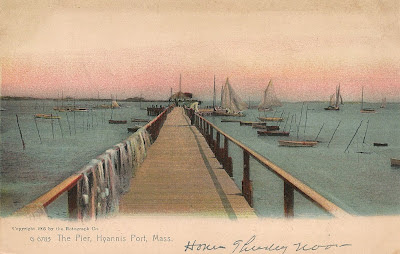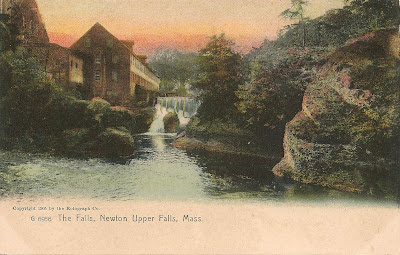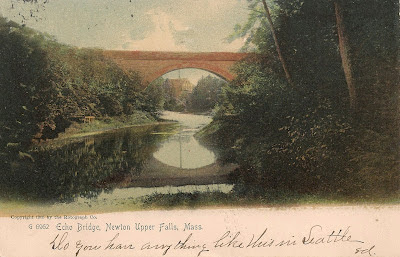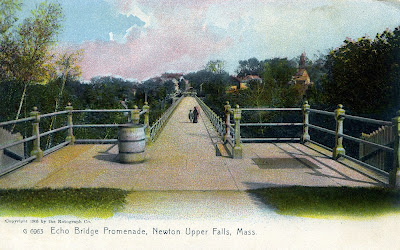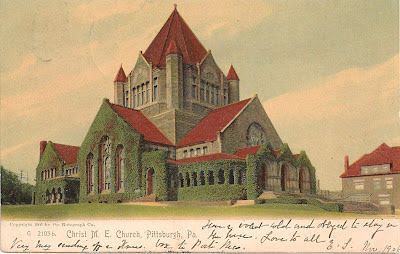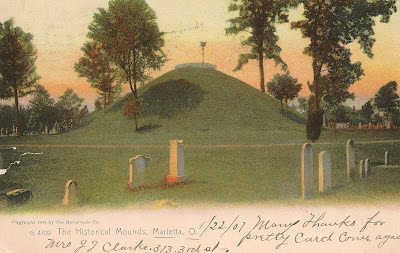
[This project, while not completed (it is in fact meant to be open-ended) has reached a point where it can be considered established, and I plan to add new material far more sporadically in the future so that I can return to other endeavors. Below is the first installment of a two-part overview of some of the interpretive aspects of the project. This post deals with aesthetic issues; the next will look at the use of Rotograph's work as historical evidence.]
The Rotograph Company produced tens of thousands of scenic views in its brief history. Its photographers -- whoever they may have been, since by and large their identities seem to be unrecorded -- captured engineering marvels of the day, from bridges and canals to skyscrapers; they documented the civic and religious buildings of small towns as well as the well-tended monuments with which Americans declared their connections to their own past; they depicted the seaside resorts and tourist traps of an early 20th-century America where increasing numbers of people went to taste the benefits of leisure time; above all, they preserved in material, visible form both the country's physical appearance and, equally important, evidence of how Americans conceived of the land they inhabited.
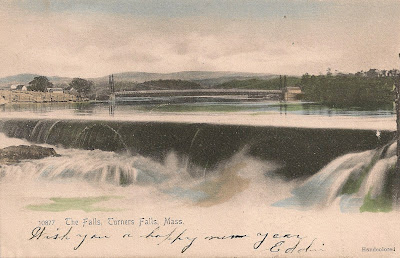
The archive of images that they created was broad and rich, but it was not unselective. In general, Rotograph's view cards show us little of factories and sweatshops, bars and missions, tenements and shantytowns, and much else that we know -- and that its audience knew -- was in fact present. Unlike Jacob Riis or the WPA photographers of the 1930s, the company did not deliberately set out to confront Americans with aspects of their country that were normally concealed or ignored. Nor were they carrying on the same task as the countless thousands of small-town professional photographers and amateur shutterbugs who, in the first decades of the twentieth century, preserved images of everything from family life to lynchings in continuous-tone "Real Photo" photographic postcards.
Without denying the active role that the company's photographers, printers, and management played in creating the images, in the end what was shot, printed, and distributed was determined, above all, by market considerations. But acknowledging that fact inevitably leads to the question -- which I will not attempt to answer but do intend to raise -- of
why the market wanted certain things: what scenes of their country were Americans interested in seeing, and how did they want them to be depicted?


The postcard boom of the early 20th century paralleled the flowering of other forms of popular art and entertainment that were affordable to all but the poorest Americans, from the newspaper comic to the motion picture and the phonograph record. Although tintypes, cartes de visite, and other inexpensive photographic media had been available for decades, the rise of the postcard greatly expanded the inventory of images that could be manufactured, distributed, and exchanged. This project has only been concerned with scenic view cards, but the postcard format was adaptable to everything from salacious humor to sentimentality to reproductions of fine artworks that would normally only be seen by those with access to the collections of one of the great metropolitan museums.
The mass production of postcard images by lithographic screen processes, rather than by continuous-tone true photographic printing, entailed certain limitations. The crucial one, from the perspective of this project, was the matter of color. The challenge lay not so much in printing color per se as in
reproducing the richness and subtleties of color that were encountered in the real world. Despite some promising early experiments, mass-produced true-color photographic reproduction was not yet feasible.

In response, postcard manufacturers developed a workaround. They would not attempt to directly employ the output of the camera lens as a medium for transferring information about real-world coloration to the finished project. Instead, they would start from a black-and-white original and artificially introduce appropriate pigmentation during the printing process. When done crudely and cheaply, the results were unimpressive, but in skillful hands the resulting images could be, if not fully true-to-life, satisfactorily pleasing to the eye. The ultimate goal, let us remind ourselves, was to entice a buyer.
But something odd happens here. Photographic images that might have seemed utterly pedestrian in black-and-white took on an extra dimension when carefully printed in color (or when colored wholly or partly by hand, as some Rotographs were). Coloring did more than restore natural hues; it created artificial objects with supernormal aesthetic qualities of their own. The great accomplishment of the coloring process lay not in better capturing the real world but in
creating a different one.

Photography is, of course, an artistic genre, and a photograph, if taken with any kind of attention, is always more than a passive reflection of its subject. Even photographers with proclaimed "documentary" intentions are guided, to a greater or lesser degree, by aesthetic principles. But by applying a second level of artistic intervention to the original photograph, Rotograph's printers created hybrid images in which more than one strata of artistic activity could be seen to be at work. The finished postcards were
documentary, because they were constrained by the real world that was present to be filtered through the photographer's lens, but they were also
imaginary, because they had been manipulated in ways that corresponded both to notions of what coloring was appropriately natural and to judgments about what would be pleasing to the eye.
This manipulation -- which, I might add, anticipated the use of hybrid, "impure," artistic techniques like André Breton's collages, the incorporation of "found" objects and textures in the constructions of Joseph Cornell, and Andy Warhol's Pop Art employment of photographs as a base for silk-screened prints, to cite just a few examples -- produced artworks that were aesthetically irreducible. That is, it's impossible to casually dismiss them as nothing but kitsch created to satisfy a particular market fad and to flatter the self-image of the buyers, who were largely American citizens with a vested interest in beholding images of the country that reinforced a certain national ideology. The cards may indeed have been all that, but they also had an additional dimension, a disruptive strangeness, that may have been invisible to those who created and purchased them.

Looking at these postcards now, hopefully with a minimum of nostalgia, we miss much of the original context of associations that would have been familiar to their original creators and beholders, but in exchange we are able to see them through the perspective of subsequent artistic, technological, and historical developments, and we can see how technical limitations and the constraints of the market prompted creative solutions that can be encompassed within the broader history of producing -- and regarding -- art during the past one hundred years.
All of which is perhaps only a long-winded and abstruse way of saying that the artistic possibilities opened up by these images have not necessarily been followed to their exhaustion.
